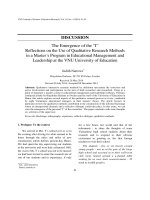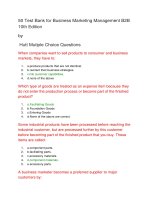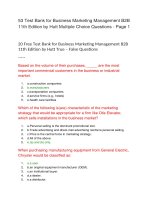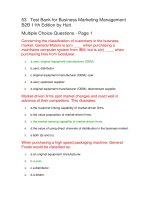Business marketing management b2b, tenth edition Michael Hutt and Thomas Speh
Bạn đang xem bản rút gọn của tài liệu. Xem và tải ngay bản đầy đủ của tài liệu tại đây (4.27 MB, 669 trang )
Business Marketing
Management: B2B
This page intentionally left blank
Business Marketing
Management: B2B
10 e
MICHAEL D. HUTT
Arizona State University
•
THOMAS W. SPEH
Miami University
Australia • Brazil • Japan • Korea • Mexico • Singapore • Spain • United Kingdom • United States
Business Marketing Management:
B2B, Tenth Edition
Michael D. Hutt and Thomas W. Speh
Vice President of Editorial, Business:
Jack W. Calhoun
Editor-in-Chief: Melissa Acuna
Acquisitions Editor: Mike Roche
Developmental Editor: Erin Berger
Editorial Assistant: Shanna Shelton
Senior Marketing Coordinator: Sarah Rose
Executive Marketing Manager:
Kimberly Kanakes
© 2010, 2007 South-Western, Cengage Learning
ALL RIGHTS RESERVED. No part of this work covered by the copyright
hereon may be reproduced or used in any form or by any means—
graphic, electronic, or mechanical, including photocopying, recording,
taping, Web distribution, information storage and retrieval systems, or
in any other manner—except as may be permitted by the license terms
herein.
For product information and technology assistance, contact us at
Cengage Learning Customer & Sales Support, 1-800-354-9706
For permission to use material from this text or product,
submit all requests online at cengage.com/permissions
Further permissions questions can be emailed to
Content Project Manager: Melissa Sacco
Managing Media Editor: Pam Wallace
Frontlist Buyer, Manufacturing: Bev Breslin
ExamView® is a registered trademark of eInstruction Corp. Windows is
a registered trademark of the Microsoft Corporation used herein under
license. Macintosh and Power Macintosh are registered trademarks of
Apple Computer, Inc. used herein under license.
Production Service: Pre-Press PMG
© 2010 Cengage Learning. All Rights Reserved.
Media Editor: John Rich
Website Project Manager: Brent Beck
Copyeditor: Pamela Rockwell
Compositor: Pre-Press PMG
Senior Art Director: Stacy Jenkins Shirley
Internal Design: Joseph Pagliaro
Cover Design: cmilller design
Library of Congress Control Number: 2008939936
Student Edition ISBN 13: 978-0-324-58167-6
Student Edition ISBN 10: 0-324-58167-X
Cover Image: © Getty Images/Tetra Images
Instructor’s Edition ISBN 13: 978-0-324-78923-2
Photography Manager: Deanna Ettinger
Instructor’s Edition ISBN 10: 0-324-78923-8
Photo Researcher: Pre-PressPMG
South-Western Cengage Learning
5191 Natorp Boulevard
Mason, OH 45040
USA
Cengage Learning products are represented in Canada by Nelson
Education, Ltd.
For your course and learning solutions, visit www.cengage.com
Purchase any of our products at your local college store or at our
preferred online store www.ichapters.com
Printed in Canada
1 2 3 4 5 6 7 8 12 11 10 09
To Rita and to Sara, and in memory of Michele
This page intentionally left blank
PREFACE
Special challenges and opportunities confront the marketer who intends to serve the
needs of organizations rather than households. Business-to-business customers represent a lucrative and complex market worthy of separate analysis. A growing number
of collegiate schools of business in the United States, Canada, and Europe have added
industrial or business marketing to their curricula. In addition, a large and growing
network of scholars in the United States and Europe is actively engaged in research
to advance theory and practice in the business marketing field. Both the breadth and
quality of this research has increased markedly during the past decade.
The rising importance of the field can be demonstrated by several factors. First, because more than half of all business school graduates enter firms that compete in business markets, a comprehensive treatment of business marketing management appears to
be particularly appropriate. The business marketing course provides an ideal platform
to deepen a student’s knowledge of the competitive realities of the global marketplace,
customer relationship management, cross-functional decision-making processes, supply
chain management, e-commerce, and related areas. Such core content areas strike a responsive chord with corporate recruiters and squarely address key educational priorities
established by the American Assembly of Collegiate Schools of Business (AACSB).
Second, the business marketing course provides a perfect vehicle for examining the
special features of high-technology markets and for isolating the unique challenges that
confront the marketing strategist in this arena. High-tech markets represent a rapidly
growing and dynamic sector of the world economy and a fiercely competitive global battleground but often receive only modest attention in the traditional marketing curriculum.
Electronic (e) commerce also falls squarely into the domain of the business market. In
fact, the opportunity for e-commerce in the business-to-business market is estimated to be
several times larger than the opportunity that exists in the business-to-consumer market.
Third, the Institute for the Study of Business Markets (ISBM) at Pennsylvania State
University has provided important impetus to research in the area. ISBM has become a
major information resource for researchers and practitioners and has assumed an active
role in stimulating and supporting research on substantive business marketing issues.
In turn, the number of research studies centered on the business-to-business domain
has significantly expanded in recent years, and specialized journals in the area attract a
steady stream of submissions. The hard work, multiyear commitments, and leadership
of the editors of these journals are worthy of note: Journal of Business-to-Business Marketing, J. David Lichtenthal, Baruch College; Journal of Business & Industrial Marketing,
Wesley J. Johnston, Georgia State University; and Industrial Marketing Management,
Peter LaPlaca, University of Connecticut.
Three objectives guided the development of this edition:
1. To highlight the similarities between consumer-goods and business-to-business
marketing and to explore in depth the points of departure. Particular attention is
given to market analysis, organizational buying behavior, customer relationship
management, supply chain management, and the ensuing adjustments required
in the marketing strategy elements used to reach organizational customers.
2. To present a managerial rather than a descriptive treatment of business
marketing. Whereas some descriptive material is required to convey the
vii
viii
Preface
dynamic nature of the business marketing environment, the relevance of the
material is linked to marketing strategy decision making.
3. To integrate the growing body of literature into a strategic treatment of business
marketing. In this text, relevant work is drawn from organizational buying
behavior, procurement, organizational behavior, supply chain management,
strategic management, and the behavioral sciences, as well as from specialized
studies of business marketing strategy components.
The book is structured to provide a complete and timely treatment of business
marketing while minimizing the degree of overlap with other courses in the marketing
curriculum. A basic marketing principles course (or relevant managerial experience)
provides the needed background for this text.
New to This Edition
Although the basic objectives, approach, and style of earlier editions have been maintained, several changes and additions have been made that reflect both the growing
body of literature and the emerging trends in business marketing practice. Specifically,
the following themes and distinctive features are incorporated into the tenth edition:
• Relationship Marketing Strategies: new and expanded coverage of the drivers
of relationship marketing effectiveness and the financial impact of relationship
marketing programs.
• Strategic Alliances: a timely and richly illustrated discussion of the determinants and social ingredients of alliance success.
• Strong B2B Brands: specific steps for building and managing a profitable B2B
brand.
• Marketing Performance Measurement: a timely treatment of specific metrics
for measuring the impact of marketing strategy decisions on firm performance.
• A Value-Based Approach for Pricing: a timely description of a framework for
identifying and measuring value by customer segment.
• A Customer-Centered Approach to Channel Design: a fresh approach for
designing channels from the bottom up, rather than the top down.
• Other new topics of interest: the new edition includes expanded treatment of
customer experience management, corporate entrepreneurship, strategic
positioning, and the emerging trends in online advertising strategies.
Organization of the Tenth Edition
The needs and interests of the reader provided the focus in the development of this volume. The authors’ goal is to present a clear, timely, and engaging examination of business marketing management. To this end, each chapter provides an overview, highlights
key concepts, and includes several carefully chosen examples of contemporary business
Preface
ix
marketing practice, as well as a cogent summary and a set of provocative discussion
questions. Contemporary business marketing strategies and challenges are illustrated
with three types of vignettes: “B2B Top Performers,” “Inside Business Marketing,” and
“Ethical Business Marketing.”
The book is divided into six parts with a total of 17 chapters. Part I introduces the
distinguishing features of the business marketing environment. Careful examination
is given to each of the major types of customers, the nature of the procurement function, and key trends that are reshaping buyer-seller relationships. Relationship management establishes the theme of Part II, in which chapter-length attention is given
to organizational buying behavior and customer relationship management. By thoroughly updating and illustrating the core content, this section provides a timely and
comprehensive treatment of customer profitability analysis and relationship management strategies for business markets. After this important background is established,
Part III centers on the techniques that can be applied in assessing market opportunities:
market segmentation and demand analysis, including sales forecasting.
Part IV centers on the planning process and on designing marketing strategy for
business markets. Recent work drawn from the strategic management and strategic
marketing areas provides the foundation for this section. This edition provides an
expanded and integrated treatment of marketing strategy development using the balanced scorecard, enriched by strategy mapping. Special emphasis is given to defining
characteristics of successful business-to-business firms and to the interfacing of marketing with other key functional areas such as manufacturing, research and development, and customer service. This functionally integrated planning perspective serves
as a focal point in the analysis of the strategy development process. Here at the core of
the volume, a separate chapter provides an integrated treatment of strategy formulation for the global market arena, giving particular attention to the new forms of competitive advantage that rapidly developing economies present (for example, China).
Next, each component of the marketing mix is examined from a business marketing perspective. The product chapter gives special attention to the brand-building
process and to the strategic importance of providing competitively superior value to
customers. Adding further depth to this core section are the chapters on managing
product innovation and managing services for business markets. In turn, special attention is given to e-commerce and supply chain strategies for business markets. Building
on the treatment of customer relationship marketing provided in Part II, the personal
selling chapter explores the drivers of relationship marketing effectiveness as well as
the financial impact of relationship marketing programs.
Marketing performance measurement provides the central focus for Part V. It
provides a compact treatment of marketing control systems and uses the balanced
scorecard as an organizing framework for marketing profitability analysis. Special attention is given to identifying the drivers of marketing strategy performance and to
the critical area of strategy implementation in the business marketing firm. Part VI
includes a collection of cases tailored to the business marketing environment.
Cases
Part VI includes 12 cases, 8 of which are new to this edition. These cases, of varying lengths, isolate one or more business marketing problems. Included among the
selections for this edition are cases that raise provocative issues and illustrate the
x
Preface
challenges and opportunities that small firms confront and the best practices of leadingedge firms such as Medtronics Corporation, Hewlett-Packard, FedEx, and 3M
Canada. Other cases new to this edition provide students with a variety of business
marketing strategy applications. A Case Planning Guide, which keys the cases to relevant text chapters, provides an organizing structure for Part VI. In addition, a short
case, isolating core concepts, is included with each chapter. Two-thirds of the endof-chapter cases are new to this edition and uncover opportunities and challenges
confronting firms such as Apple, Intuit, Sealed Air Corp, SunPower, and Cisco.
These cases provide a valuable tool for sparking class discussion and bringing strategy issues to life.
Ancillary Package
We are most indebted to John Eaton, Arizona State University, for his fine work in
bringing together all of the elements of the ancillary package so that all supplements
work together seamlessly. The ancillary package includes:
Instructor’s Resource CD (IRCD)
The Instructor’s Resource CD delivers all the traditional instructor support materials
in one handy place: a CD. Included on the CD are electronic files for the complete Instructor’s Manual, Test Bank, computerized Test Bank and computerized Test Bank
software (ExamView), and chapter-by-chapter PowerPoint presentation files that can
be used to enhance in-class lectures. PowerPoint files have been thoroughly updated
and feature hundreds of new slides that instructors can use to tailor their lectures to
their particular needs and preferences. We are indebted to Ray DeCormier, Central
Connecticut State University, for developing the PowerPoint files and for contributing his expertise to this project.
Instructor’s Manual The Instructor’s Manual for the tenth edition of Business
Marketing Management: B2B provides a variety of creative suggestions designed to
help the instructor incorporate all the materials available to create a dynamic learning
environment. A few of the key features available in the Instructor’s Manual for this
edition include
• course design suggestions
• chapter outlines and supporting chapter materials
• suggested readings listed by chapter
• case analysis suggestions as well as assessment rubrics
• cooperative learning exercises
• ideas for effectively integrating the video package into the classroom
discussion
The Instructor’s Manual files are located on the IRCD and are also available for
download at the text support site, />
Preface
xi
Test Bank The revised and updated Test Bank includes over 1,500 multiple-choice
and true/false questions, emphasizing the important concepts presented in each chapter, along with an average of five essay questions per chapter. The Test Bank questions vary in levels of difficulty so that each instructor can tailor the testing to meet
specific needs. Each question is tagged to AACSB standards, discipline guidelines,
and Rubin/Dierdorff standards. The Test Bank files are located on the IRCD.
ExamView (Computerized) Test Bank The Test Bank is also available on the
IRCD in computerized format (ExamView), allowing instructors to select problems
at random by level of difficulty or type, customize or add test questions, and scramble
questions to create up to 99 versions of the same test. This software is available in
Mac or Windows formats.
PowerPoint Presentation Slides The PowerPoint presentation slides bring classroom lectures and discussions to life with the Microsoft PowerPoint presentation tool.
These presentations are organized by chapter, helping to create an easy-to-follow lecture, and are extremely professor friendly and easy to read. There are two PowerPoint versions for this edition: the GOLD version includes varying slide background
and animation; the SILVER version provides simpler design for professors who would
like to add their own material. The PowerPoint presentation slides are available on
the IRCD and as downloadable files on the text support site, gage
.com/marketing/hutt.
Web Site
Visit the text Web site at to find instructor’s support materials as well as study resources that will help students practice and
apply the concepts they have learned in class.
Videos
A new video package has been prepared to provide a relevant and interesting visual
teaching tool for the classroom. Each video segment applies text materials to the real
world, demonstrating how everyday companies effectively deal with business marketing management issues.
Student Resources
Online quizzes for each chapter are available on the Web site for those students who
would like additional study materials. After each quiz is submitted, automatic feedback
tells the students how they scored and what the correct answers are to the questions
they missed. Students are then able to e-mail their results directly to their instructor,
if desired.
Acknowledgments
The development of a textbook draws upon the contributions of many individuals. First,
we would like to thank our students and former students at Arizona State University,
xii
Preface
Miami University, the University of Alabama, and the University of Vermont. They provided important input and feedback when selected concepts or chapters were originally
class tested. We would also like to thank our colleagues at each of these institutions for
their assistance and support.
Second, we express our gratitude to several distinguished colleagues who carefully reviewed the volume and provided incisive comments and valuable suggestions
that improved the tenth edition. They include: Blaine Branchik, Quinnipiac University;
Brian Brown, University of Massachusetts, Amherst; Abbie Griffin, University of Utah;
Peter A. Reday, Youngstown State University; Larry P. Schramm, Oakland University;
Judy Wagner, East Carolina University; and Jianfeng Wang, Mansfield University of
Pennsylvania.
We would also like to express our continuing appreciation to others who provided important suggestions that helped shape earlier editions: Kenneth Anselmi, East
Carolina University; Joseph A. Bellizzi, Arizona State University; Paul D. Boughton,
Saint Louis University; Michael R. Czinkota, Georgetown University; S. Altan Erdem,
University of Houston–Clear Lake; Troy Festervand, Middle Tennessee State University;
Srinath Gopalakrishna, University of Missouri, Columbia; Paris A. Gunther, University
of Cincinnati; Jon M. Hawes, University of Akron; Jonathan Hibbard, Boston University;
Lee Hibbert, Freed-Hardeman University; George John, University of Minnesota; Joe H.
Kim, Rider University; Kenneth M. Lampert, Metropolitan State University, Minnesota;
Jay L. Laughlin, Kansas State University; J. David Lichtenthal, Baruch College; Gary L.
Lilien, Pennsylvania State University; Lindsay N. Meredith, Simon Fraser University;
K. C. Pang, University of Alabama at Birmingham; Richard E. Plank, University of South
Florida; Constantine Polytechroniou, University of Cincinnati; Bernard A. Rausch,
Illinois Institute of Technology; David A. Reid, The University of Toledo; Paul A. Roobol,
Western Michigan University; Beth A. Walker, Arizona State University; Elizabeth
Wilson, Suffolk University; James F. Wolter, Grand Valley State University; Ugut
Yucelt, Pennsylvania State University at Harrisburg; and John M. Zerio, American
Graduate School of International Management.
We are especially indebted to four members of the Board of Advisors for Arizona State University’s Center for Services Leadership. Each served as a senior executive sponsor for a funded research study, provided access to the organizations, and
contributed valuable insights to the research. Collectively, these studies sharpened
the strategy content of the volume. Included here are Michael Daniels, Senior Vice
President, Global Technology Services, IBM Global Services; Greg Reid, Chief Marketing Officer, YRC Worldwide Inc.; Adrian Paull, Vice President, Customer Product
Support, Honeywell Aerospace; and Merrill Tutton, President, AT&T UK, retired. We
would like to thank Jim Ryan, President and Chief Executive Officer, W. W. Grainger,
for his insights and contributions to this edition. We would also like to thank
Mohan Kuruvilla, Adjunct Professor, Indian Institute of Management Kozhikode, for his
keen insights and recommendations. We also extend our special thanks to Dr. Joseph
Belonax, Western Michigan University, for contributing ideas and content to the teaching package.
The talented staff of South-Western/Cengage Learning displayed a high level of
enthusiasm and deserves special praise for their contributions in shaping this edition.
In particular, Mike Roche provided valuable advice and keen insights for this edition.
In turn, we were indeed fortunate to have Erin Berger, our development editor, on
our team. Her steady hand, efficient style, and superb coordinating skills advanced the
project. Pamela Rockwell contributed excellent copyediting skills and Melissa Sacco,
Preface
xiii
our Project Manager, provided a confident style and a seasoned approach during
the production process. We express our gratitude to Diane A. Davis, Arizona State
University, for lending her superb administrative skills and creative talent to the
project and for delivering under pressure.
Finally, but most importantly, our overriding debt is to our wives, Rita and Sara,
whose encouragement, understanding, and direct support were vital to the completion of this edition. Their involvement and dedication are deeply appreciated.
Michael D. Hutt
Thomas W. Speh
ABOUT THE AUTHORS
Michael D. Hutt (PhD, Michigan State University) is the Ford Motor Company
Distinguished Professor of Marketing at the W. P. Carey School of Business, Arizona
State University. He has also held faculty positions at Miami University (Ohio) and
the University of Vermont.
Dr. Hutt’s teaching and research interests are concentrated in the areas of businessto-business marketing and strategic marketing. His current research centers on the crossfunctional role that marketing managers assume in the formation of strategy. Dr. Hutt’s
research has been published in the Journal of Marketing, Journal of Marketing Research,
MIT Sloan Management Review, Journal of Retailing, Journal of the Academy of Marketing
Science, and other scholarly journals. He is also the co-author of Macro Marketing ( John
Wiley & Sons) and contributing author of Marketing: Best Practices (South-Western).
Assuming a variety of leadership roles for American Marketing Association programs, he co-chaired the Faculty Consortium on Strategic Marketing Management.
He is a member of the editorial review boards of the Journal of Business-to-Business
Marketing, Journal of Business & Industrial Marketing, Industrial Marketing Management, Journal of the Academy of Marketing Science, and Journal of Strategic Marketing.
For his 2000 contribution to MIT Sloan Management Review, he received the Richard
Beckhard Prize. Dr. Hutt has consulted on marketing strategy issues for firms such as
IBM, Motorola, Honeywell, AT&T, Arvin Industries, ADT, and Black-Clawson, and
for the food industry’s Public Policy Subcommittee on the Universal Product Code.
Thomas W. Speh, PhD, is Professor of Marketing Emeritus and Associate Director
of MBA Programs at the Farmer School of Business, Miami University (Ohio).
Dr. Speh earned his PhD from Michigan State University. Prior to his tenure at
Miami, Dr. Speh taught at the University of Alabama.
Dr. Speh has been a regular participant in professional marketing and logistics
meetings and has published articles in a number of academic and professional journals, including the Journal of Marketing, Sloan Management Review, Harvard Business
Review, Journal of the Academy of Marketing Sciences, Journal of Business Logistics, Journal
of Retailing, Journal of Purchasing and Materials Management, and Industrial Marketing
Management. He was the recipient of the Beta Gamma Sigma Distinguished Faculty
award for excellence in teaching at Miami University’s School of Business and of the
Miami University Alumni Association’s Effective Educator award.
Dr. Speh has been active in both the Warehousing Education and Research
Council (WERC) and the Council of Logistics Management (CLM). He has served as
president of WERC and as president of the CLM. Dr. Speh has been a consultant on
strategy issues to such organizations as Xerox, Procter & Gamble, Burlington Northern Railroad, Sara Lee, J. M. Smucker Co., and Millenium Petrochemicals, Inc.
xiv
CASE CONTRIBUTORS
Erin Anderson, INSEAD
Bradley W. Brooks, Queens University of Charlotte
Clayton M. Christensen, Harvard Business School
Terry H. Deutscher, Richard Ivey School of Business
Ali F. Farhoomand, University of Hong Kong
John H. Friar, Northeastern University
John B. Gifford, Miami University (Ohio)
Raymond M. Kinnunen, Northeastern University
Marc H. Meyer, Northeastern University
David W. Rosenthal, Miami University (Ohio)
David V. Rudd, Lebanon Valley College
Susan Sieloff, Northeastern University
Robert E. Spekman, Darden School of Business, University of Virginia
David Weinstein, INSEAD
John M. Zerio, Thunderbird School of Global Management
xv
CONTENTS IN BRIEF
Preface
PART I
PART II
PART III
PART IV
xvi
vii
THE ENVIRONMENT OF BUSINESS MARKETING
1
Chapter 1 A Business Marketing Perspective
3
Chapter 2 The Business Market: Perspectives
on the Organizational Buyer
33
MANAGING RELATIONSHIPS IN BUSINESS MARKETING
61
Chapter 3 Organizational Buying Behavior
63
Chapter 4 Customer Relationship Management
Strategies for Business Markets
91
ASSESSING MARKET OPPORTUNITIES
121
Chapter 5 Segmenting the Business Market
and Estimating Segment Demand
123
FORMULATING BUSINESS MARKETING STRATEGY
151
Chapter 6 Business Marketing Planning:
Strategic Perspectives
153
Chapter 7 Business Marketing Strategies
for Global Markets
180
Chapter 8 Managing Products
for Business Markets
208
Chapter 9 Managing Innovation and New
Industrial Product Development
232
Contents in Brief
PART V
xvii
Chapter 10 Managing Services
for Business Markets
257
Chapter 11 Managing Business
Marketing Channels
281
Chapter 12 E-Commerce Strategies
for Business Markets
303
Chapter 13 Supply Chain Management
329
Chapter 14 Pricing Strategy for
Business Markets
358
Chapter 15 Business Marketing Communications:
Advertising and Sales Promotion
383
Chapter 16 Business Marketing Communications:
Managing the Personal
Selling Function
407
EVALUATING BUSINESS MARKETING
STRATEGY AND PERFORMANCE
Chapter 17 Marketing Performance
Measurement
433
435
Cases
462
Name Index
609
Subject Index
619
CONTENTS
Preface
PART I
vii
THE ENVIRONMENT OF BUSINESS MARKETING
Chapter 1
A Business Marketing Perspective
Business Marketing
Business Marketing Management
Business Market Customers
3
4
5
6
B2B TOP PERFORMERS: Jim Ryan, President and Chief Executive Officer,
W.W. Grainger, Inc.
Business Markets versus Consumer-Goods Markets
7
7
B2B TOP PERFORMERS: Career Path for B2B CEOs: For Many,
It Began in Marketing!
9
Creating the Customer Value Proposition
Marketing’s Cross-Functional Relationships
Characteristics of Business Markets
Business and Consumer Marketing: A Contrast
10
11
13
14
Smucker: A Consumer and Business Marketer
Distinguishing Characteristics
A Relationship Emphasis
The Supply Chain
Supply Chain Management
15
16
16
17
18
Managing Relationships in the Supply Chain
Commercial Enterprises as Consumers
19
21
INSIDE BUSINESS MARKETING: The iPhone: A Triumph of Supply Chain
Management Too
Classifying Goods for the Business Market
Entering Goods
Foundation Goods
Facilitating Goods
Business Marketing Strategy
Illustration: Manufactured Materials and Parts
Illustration: Installations
Illustration: Supplies
A Look Ahead
Summary
xviii
1
22
22
23
24
24
26
26
26
26
27
29
Contents
xix
Discussion Questions
29
Internet Exercises
Case: R.I.M.’s BlackBerry and Apple’s iPhone: The Face-Off
in the Business Market
30
New Strategy Directions
Discussion Questions
31
32
Chapter 2
The Business Market: Perspectives
on the Organizational Buyer
31
33
Commercial Enterprises: Unique Characteristics
Distribution by Size
Geographical Concentration
34
35
35
Classifying Commercial Enterprises
The Purchasing Organization
Goals of the Purchasing Function
36
37
38
INSIDE BUSINESS MARKETING: The Supply Chain for McNuggets
Strategic Procurement
39
INSIDE BUSINESS MARKETING: Respond with Value-Based Selling Tools
E-Procurement
43
39
Everyone Is Getting Wired
Enhancing the Buyer’s Capabilities
44
44
45
Delivering Measurable Results
Buying Direct and Indirect Goods
Reverse Auctions
45
45
46
ETHICAL BUSINESS MARKETING: Gift Giving: “Buy Me These
Boots and You’ll Get My Business”
How Organizational Buyers Evaluate Potential Suppliers
Governments: Unique Characteristics
E-Government
Influences on Government Buying
Understanding Government Contracts
Telling Vendors How to Sell: Useful Publications
Purchasing Organizations and Procedures: Government
Federal Buying
A Different Strategy Required
The Institutional Market: Unique Characteristics
Institutional Buyers: Purchasing Procedures
Dealing with Diversity: A Market-Centered Organization
47
47
47
49
49
49
50
50
52
53
53
54
57
xx
Contents
PART II
Summary
57
Discussion Questions
Internet Exercises
58
59
Case: Sealed Air Corporation: Delivering Packaging Solutions
Discussion Questions
60
60
MANAGING RELATIONSHIPS IN BUSINESS MARKETING
Chapter 3
Organizational Buying Behavior
61
63
The Organizational Buying Process
The Search Process
New Task
Straight Rebuy
65
66
67
68
Modified Rebuy
Forces Shaping Organizational Buying Behavior
Environmental Forces
Organizational Forces
Strategic Priorities in Purchasing
69
71
71
73
73
Organizational Positioning of Purchasing
75
INSIDE BUSINESS MARKETING: Go Digital to Target
Buying Influentials
Group Forces
77
77
INSIDE BUSINESS MARKETING: Innovate and Win with BMW
Individual Forces
80
82
B2B TOP PERFORMERS: Delivering Customer Solutions
The Organizational Buying Process: Major Elements
Summary
Discussion Questions
84
85
86
87
Internet Exercises
Case: The Tablet PC for Nurses: A Mobile Clinical Assistant
Discussion Questions
Chapter 4
Customer Relationship Management
Strategies for Business Markets
Relationship Marketing
Types of Relationships
Value-Adding Exchanges
Nature of Relationships
Strategic Choices
88
89
90
91
92
93
94
94
94
Contents
B2B TOP PERFORMERS: Understanding the Customer’s
Business—The Key to Success
Managing Buyer-Seller Relationships
95
95
Transactional Exchange
95
Collaborative Exchange
Switching Costs
96
96
Strategy Guidelines
Measuring Customer Profitability
97
99
Activity-Based Costing
99
Unlocking Customer Profitability
The Profitable Few
99
100
Managing High- and Low-Cost-to-Serve Customers
Managing Unprofitable Customers
101
103
Firing Customers
Customer Relationship Management
Acquiring the Right Customers
103
104
104
INSIDE BUSINESS MARKETING: Diversify a Customer Portfolio Too!
Crafting the Right Value Proposition
Instituting the Best Processes
PART III
xxi
106
107
109
Motivating Employees
Learning to Retain Customers
Strategic Alliances
Accessing Complementary Skills
Benefits of Strategic Alliances
Determinants of Alliance Success
110
111
112
112
113
114
The Social Ingredients of Alliance Success
Summary
Discussion Questions
Internet Exercises
Case: Hewlett-Packard Challenges from a Diverse Mix
of Demanding Customers
116
118
118
119
ASSESSING MARKET OPPORTUNITIES
Chapter 5
Segmenting the Business Market
and Estimating Segment Demand
Business Market Segmentation Requirements and Benefits
Requirements
Benefits
120
121
123
125
125
125
xxii
Contents
INSIDE BUSINESS MARKETING: How to See What’s Next
Bases for Segmenting Business Markets
Macrolevel Bases
127
128
Microlevel Bases
131
B2B TOP PERFORMERS: Steering Customers to the
Right Channel
Illustration: Microsegmentation
The Segmentation Process
Choosing Market Segments
INSIDE BUSINESS MARKETING: A Fresh Approach to Segmentation:
Customer Service Segmentation
Isolating Market Segment Profitability
Implementing a Segmentation Strategy
Estimating Segment Demand
The Role of the Demand Estimation
INSIDE BUSINESS MARKETINGL: Accurate Forecasts
Drive Effective Collaboration between Boeing and Alcoa
Methods of Forecasting Demand
Qualitative Techniques
133
136
136
136
137
138
139
139
140
141
142
142
Quantitative Techniques
CPFR: A New Collaborative Approach to Estimating Demand
144
145
Combining Several Forecasting Techniques
Summary
Discussion Questions
Internet Exercises
146
147
147
148
Case: Federated Insurance: Targeting Small
Businesses
PART IV
126
Cultivating Business Relationships
149
149
Discussion Questions
150
FORMULATING BUSINESS MARKETING STRATEGY
Chapter 6
Business Marketing Planning:
Strategic Perspectives
Marketing’s Strategic Role
The Hierarchy of Strategies
Strategy Formulation and the Hierarchy
151
153
154
154
156
Contents
INSIDE BUSINESS MARKETING: From Bullet-Point Plans
to Strategic Stories at 3M
Functionally Integrated Planning: The Marketing Strategy Center
B2B TOP PERFORMERS: Cross-Functional Relationships: Effective
Managers Deliver on Promises
xxiii
158
158
159
The Components of a Business Model
160
Customer Interface
Core Strategy
162
163
Strategic Resources
The Value Network
Strategic Positioning
164
164
Strategic Positioning Illustrated
166
167
Building the Strategy Plan
The Balanced Scorecard
Financial Perspective
Customer Perspective
Internal Business Process Perspective
Strategy Map
Summary
Discussion Questions
Internet Exercises
Case: Microsoft Targets Small and Mid-Sized Businesses
Challenging Intuit, Inc.
Discussion Questions
Chapter 7
Business Marketing Strategies
for Global Markets
Capturing Global Advantage in Rapidly Developing Economies
Mapping Sources of Global Advantage
The Cost Advantage
The Market Access Advantage
The Capabilities Advantage
INSIDE BUSINESS MARKETING: How Offshore Outsourcing
Affects Customer Satisfaction—and a Company’s Stock Price!
The Outsourcing Decision
Global Market Entry Options
Exporting
165
168
168
170
171
173
175
176
177
178
178
179
180
181
182
183
186
187
188
189
190
190
xxiv
Contents
Contracting
191
Strategic Global Alliances (SGA)
Joint Ventures
192
193
ETHICAL BUSINESS MARKETING: The Bribery Dilemma in
Global Markets
194
Choosing a Mode of Entry
195
Multidomestic versus Global Strategies
195
B2B TOP PERFORMERS: General Electric Aircraft Engines:
Global Strategy Means Help Your Customers
Source of Advantage: Multidomestic versus Global
Types of International Strategy
A Strategic Framework
Global Strategy
196
197
198
199
Build on a Unique Competitive Position
Emphasize a Consistent Positioning Strategy
201
201
201
Establish a Clear Home Base for Each Distinct Business
Leverage Product-Line Home Bases at Different Locations
Disperse Activities to Extend Home-Base Advantages
Coordinate and Integrate Dispersed Activities
Managing Risk in Emerging Markets
201
202
202
202
203
Summary
Discussion Questions
203
204
Internet Exercise
Case: Schwinn: Could the Story Have Been Different?
Alternative Reality One: Aim High
205
206
206
Alternative Reality Two: If You Can’t Beat Them, Join Them
Discussion Question
206
207
Chapter 8 Managing Products for Business Markets
Building a Strong B2B Brand
Brand-Building Steps
A Systems Model for Managing a Brand
B2B TOP PERFORMERS: Corporate Brand Personality Traits
of a Successful 21st-Century Business
Product Quality and Customer Value
Meaning of Quality
Meaning of Customer Value
Product Support Strategy: The Service Connection
208
209
210
212
214
215
215
216
218









